This week’s question comes from reader Darren P. Darren wonders about something I think many people have encountered over the years…
“Road crews block bike lanes with their road work signs. The signs intended to warn us of dangers are dangerous. Is this legal? Is there a better way?”
I feel your pain Darren and this is something I’ve covered quite a bit in the past.
When I see this happen, I try to just take a deep breath (holding back my annoyance that someone has disrespected the bike lane) and merge into the adjacent lane. I can remember one instance a few years ago where a construction crew had placed a fence across the bike lane on Williams. It was so egregious (see photo at right) that I called and emailed the company about it. They responded quickly and moved the fence a few days later.
While not all construction crews have gotten the memo yet, many have. Remember the awesome, temporary bike lane crews made on N. Vancouver during a project near Legacy Emanuel Hospital last summer?
As far as I know, there is no legal accountability for this specific situation, but there are guidelines and policies.
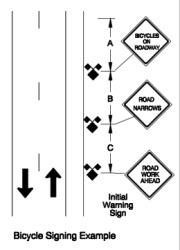
Temporary Traffic Control Handbook.
The City of Portland’s 2030 Bike Plan addresses this in section 3.6.4 “Temporary bicycle facilities during construction.” The Plan says, “When construction activities in the roadway affect bikeways, safe and convenient detour routes through or around the construction zones should be established.” Taking this policy one step further, the Plan says signage “in advance and through” work zones should be “a condition of street use permits.” That action is listed as an “immediate” priority. I took a look at a street closure permit application and, while there isn’t specific mention of bike lane blockage, there is a stipulation that some projects might warrant a “traffic control plan” to be signed off by the City Engineer.
For streets managed by ODOT, we look to the Oregon Temporary Traffic Control Handbook. The OTTCH, which is specifically for projects lasting three days or less, says a “Bicycles on Roadway” sign must be placed prior to other warning signs in any work zone where “a significant volume of bicycles can be expected and the work requires bicycles to use the travel lanes.”
So, it turns out that yes, road crews can block bike lane, but they should be sensitive with the placement of their signs. And in case you’re wondering what you can do if you see a dangerous and/or poorly placed construction sign, your best bet would be the City’s 823-SAFE (7233) hotline.
As always, I now turn to you for wisdom and input on this issue…
Got a burning bike question? Let us hear it. For more questions and the illuminating answers of our most intelligent readers, check out the Ask BikePortland archives.


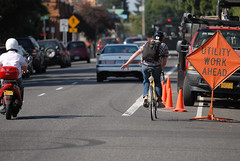
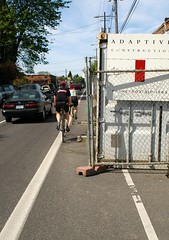
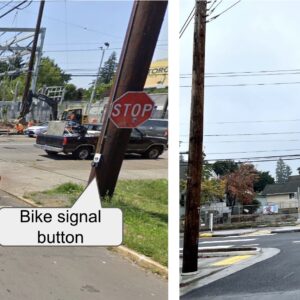
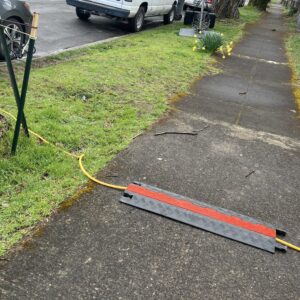
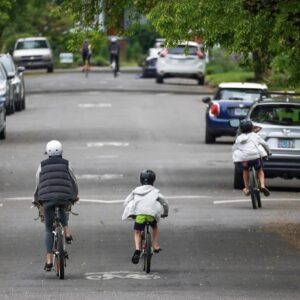
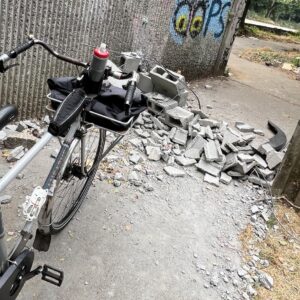
Thanks for reading.
BikePortland has served this community with independent community journalism since 2005. We rely on subscriptions from readers like you to survive. Your financial support is vital in keeping this valuable resource alive and well.
Please subscribe today to strengthen and expand our work.
The operative word is “should”, which in the Manual on Uniform Traffic Control Devices (as close to a “bible” as there is, and upon which many other guidelines are based) loosely translates to “optional”. Essentially, “shall” means if they don’t do it, they’re in violation, whereas “should” means they know they should, but don’t have to.
Interesting, since a series of signs plus cone taper, etc. are required for taking a full traffic lane, even when other lanes are available. The bike lane (where we are encouraged to ride) is treated largely as “the shoulder” when the space is required for maintenance or construction.
Bend and Eastern Oregon have their own manual too, it’s called the Bend & Eastern Oregon Temporary Traffic Control Handbook… or BEOTTCH.
(April fool’s)
just move the construction signs out of the bike lane left into the adjacent lane
Burr, NOW you’re talkin’!
All work within the City of Portland right-of-way requires an extensive permit process that requires the submittal and approval of a traffic control plan. On bike routes, the approved plan must accommodate bikes and pedestrians. On low volume roads it may include signs noting bikes in lane or on high volume roads a flagger may be needed to stop traffic to allow bikes to safely merge into the lane. There are also frequently restrictions on the time of day or time of year the road can be closed. I suspect that most of the culprits are not following the conditions of their permit or didn’t get the permit in the first place. This always cheeses me off, because I pay the fee, get the permit, comply with the permit conditions and look out for the safety of all road users.
There was the time that the lady decided to drive down the sidewalk rather than wait for the flagger. It turns out that her BMW was no match for our 300 pound flagger.
Curb replacement recently started on the expressway I ride on (apparently there’s enough money in California for that, but I digress). The first few days the signs forced me to take the 50 MPH HOV lane in places, but I always managed to make eye contact and smile and say “good morning” with the work crew. Within days they realized it was a popular bike commute and I noticed the signs pulled in dramatically tighter each day. On the following Monday I noticed a HUGE orange sign saying to share the right lane with bicyclists, though I never needed to after the first day or so.
My point: work with these guys, not against them (i.e. educate them that you even exist).
Today, I turned onto Clinton Street eastbound from 34th, and was directed onto the sidewalk to avoid the ongoing repaving project. But what was there waiting for me? Two construction signs, completely blocking the crosswalk. Construction flagging on Clinton has been decent so far, but they definitely dropped the ball today.
It looks like the work crew personnel change over completely whenever they move to a new segment. The guy flagging at 49th a few weeks ago was awesome. The guy today wasn’t so hot.
I have made a magical discovery.
It’s possible to ride bike without bike lane! Here’s how:
The key is looking ahead, looking behind, and judging what will happen at the point of obstruction (or lack of bike lane, for those needing it)
My neck happens to be to rotary adjustable, but some people prefer handlebar or eyeglass mounted rear view mirrors.
Look what’s ahead of you, look what’s behind you, and use good judgment.
I think the correct path for complaints is the City or County (jurisdiction) in charge of inspecting the construction project. They need to make the Contractors use appropriate signage that complies with the MUTCD. This manual tells them how to place temporary traffic control signs. It is the local jurisdiction that is responsible for making this happen. If its not a Contractor but a maintenance crew, then its the jurisdiction’s Operations and Maintenance department that’s responsible.
This article on bike lane safety is very informative. I am a professional driver and I have taken the phone number for SAFE so that I too can report unsafe road conditions. I have come to this website in the hopes of becoming better educated about the needs of bike riders and so that you all can get a better picture of a professional school bus driver. Thank you.
Hey Jonathon, great info as always.
When the construction next to my office encroached on the street (no marked bike lanes) and almost blocked the travel lane completely . . . I called the City
503.823.SAFE
and within 12 hours, they had the staff member out talking to the crew and they moved the fence back toward the property line. Worked like magic.
As stated in #1 – The Manual on Uniform Traffic Control Devices (MUTCD) is a guide, or suggested practice. If the City’s contract states that they “shall comply with the MUTCD”, then it becomes a mandate, not a mere suggestion. For private property development the City would need to have such language in their permitting documents. Bottom line is, the City or County is the best contact to make if you see problems with temporary traffic control.
Here in Corvallis we had one last summer where the construction crew provided a nice temporary bike lane in half a motor vehicle lane that they didn’t need. I sent kudos to the city’s appropriate project manager on that one.
Last spring I had a group of fifth graders on a community ride when we encountered a construction sign in the bike lane. It made for a great teachable moment about when and how to take the lane.
These were not the deep excavation sort of projects that stay in the same spot for days or weeks at a time. The setup changed from day to day.
I always get great lulz when the “bikes in roadway” sign is in the bike lane. I think, “well, I guess I will be.” Construction sucks and in inconvenient for everyone, even for the bike.
So when a multi-use path, like the Oregon Electric / Fanno Ck. Trail is closed, is there any standard for detour signage? I got bit by that this morning and ended up going north on Scholls Ferry, to Beaverton Hillsdale, to Oleson Rd. to get around it. It Kind of pissed me off.
I have made a magical discovery.
It’s possible to place construction signs in the traffic lane!
Reminds me of the warning sign I came upon last year on Cornell with a wire draped across the bike lane at head level:
http://bikeportland.org/2009/09/01/crowds-in-the-bike-lanes-today-is-first-day-of-bike-commute-challenge-22986#comment-1411147
I have made a not-so-magical discovery: bicyclists are largely disregarded and/or disrespected when it comes to traffic interruptions. If “authorities” want to go to all the trouble of creating a bike lane and legally confining us to it, then they should make provisions at least equal to those in place for when a “car” lane is blocked by construction. I have seen construction signs that were secured by a thin guy wire that was strung from the sidewalk, where the sign was positioned, diagonally across the bike lane. This wire was all-but-invisible until you were right on it, by which time no amount of rotary adjustment of one’s neck was going to help.
There are also times when adjacent traffic blocks one’s view around bends in the road, and without sufficient warning signs (such as would be placed well in advance if a “car” lane were blocked), it is impossible to see some bike lane blockages until it is too late to merge peacefully into 40mph auto traffic.
Sure, we don’t need bike lanes–many times I wish they didn’t exist–but when they do exist, they set up certain expectations, not least for drivers, about where everyone on the road is going to be. Why is it OK to suddenly change the situation without a preliminary adjustment of expectations only when it will negatively affect bicyclists?
It’s not so much about a cyclist’s ability to adapt to the many adverse conditions that tend to exist for them on the road, it’s about asking why should we tolerate those adverse conditions when other road users aren’t expected to?
Heh. #17 mentions the same guy wire I did in #18. That was the sign.
On that day, I called 911 because of the eminent danger, then dismantled the contraption myself.
Also, whenever I come across road signs (not cones or other diverters) placed IN an otherwise open bike lane, I stop and move them out of the bike lane. Done this half a dozen times. The legality of my actions is less interesting to me than the danger of the immediate situation.
@ Steve #12:
You misread and you are mistaken. The MUTCD is not a suggestion. The word “should” within an MUTCD guidline is a suggestion. An agency may be “mandated” to comply with the MUTCD, but if the MUTCD says “should”, then you can know that you should, but choose not to, and still be in compliance. Really.
rider #14 “I always get great lulz when the ‘bikes in roadway’ sign is in the bike lane”
My absolute favorite sign placement is like the ones on inner Sandy a few months ago: “Bikes in Roadway” signs in the bike lane to dodge around, and then the construction cones actually come in from the left of the traffic lane, pushing the cars over to the right edge of the road. I sure would like to see “Cars in Bike Lane” signs so the drivers get a chance to think about when they’re really supposed to yield.
As an ODOT licensed traffic control flagger, I can say that this is on the test as of last year when I was licensed. The answer is “Not unless you’ve been approved to block it, and then only with the correct traffic control devices.” There is signage and guidelines for this situation, and traffic control rules do not differentiate restricted lanes (HOV, bus, bicycle, etc) from unrestricted lanes. Please help keep my contemporaries in check and contact OSHA when you spot such a violation.